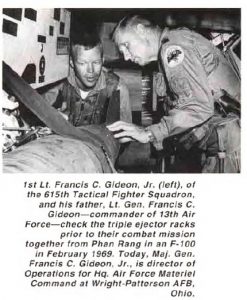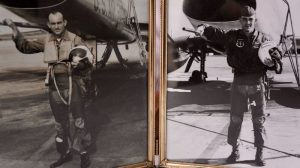Fathers and Sons in Huns.
Here are several stories from prior issues of The Intake about Father/Son F-100 pilots.
The Claim: Father and Son Hun pilots who flew an F-100 mission together. Here’s the story that originally appeared in The Intake.
A Combat Mission with Dad/Son – by Rusty Gideon
In early 1968, MGen Bob Worley, Vice Commander, 7th Air Force, was killed while flying an RF-4C in Vietnam. Readers of this magazine know the story, because Dick Rutan, Misty 40, and Don Harland were alongside in their F-100F. Following that tragedy, the 7th Air Force adopted a policy that General Officers (G.O.) would not fly in combat.
I was at Luke in Les Leavoy’s 4511th CCTS [F-100 training squadron] at the time, graduating in May 1968. I do not remember most of the IP’s very well, but two who fondly stand out in my mind are Bob Graham, “Thunder,” and “Strawberry” Reynolds. After graduation, I went off to three survival schools in a row and finally arrived at the 35th TFW, Phan Rang, in July. I was a 1st Lt standing on the taxiway where the C-130 crew tossed me out when a jeep drove up with two other lieutenants. They asked to what unit I was assigned, and I told them the 615th Bobcats. They said, “Too bad. We saw you first. You’re in the 352nd Yellow Jackets now.”
It was a nice try, but I was back in the 615th by the next afternoon. About the same time, I was checking in there, my father, LtGen Francis Gideon, was taking command of the 13th Air Force (headquarters located at Clark AFB in The Philippines). He had no units in South Vietnam, but the screwy command structure gave him administrative responsibility but no operational control of the Air Force units in Thailand. He took every opportunity to come to Thailand and Vietnam to visit his command and to see the war first hand.
In February 1969, my father decided to visit Cam Rahn Bay (32 miles north of Phan Rang), hitch a ride with some Security Cops in a jeep, and come down to Phan Rang. That seemed foolhardy to me, but he wanted to see what it was like on the ground in that area. Also, he wanted to accompany me on an F-100 combat mission. Obviously, most of us do not have an opportunity to fly in combat with family members, much less in the same airplane, so we both knew this was the chance of a lifetime. 
However, the G.O. no-fly policy was in effect, so what to do? It turned out that Gen George Brown, 7th Air Force Commander, and my dad were good friends, and Gen Brown owned the 35th Wing where I was. So, after dreaming up a few excuses about how he had to see F-100’s in action, had to understand the CAS (close air support) mission in SVN (South Vietnam), etc, etc, my father convinced Gen Brown to let him fly with me. Brown’s caveat was that the flight was not to be publicized in any way. I think I got a lecture from Col Frank Gailer, 35th TFW/CC (commander), that I had better not put any scratches on the general.
We flew in a two-ship, Al Walker leading, with my father and me in an “F” (two-seat F-100). It was a pre-planned tree-buster in northern III Corps not far from Phan Rang. The mission may not have been publicized, but Gen Brown had the last laugh, and I guarantee you that everyone who came on the radio that day knew who was in “Bobcat 12”. The FAC gave us a lucrative target and told us we could only drop our slick M-117’s (bombs) from above 3000′ and no strafing allowed. We got a nice BDA (bomb damage assessment)–100M of trench destroyed, 50M of trench damaged, 3 fighting positions destroyed, 6 bunkers destroyed, 4 bunkers damaged–and lots of atta’ boy’s for our excellent bombs. The rest of the story? There was not a VC (Viet Cong) or anything other than big trees within 50 miles of that place! Years later, in Oct 1996, long after my dad and Gen Brown had passed away, the “Air Force Magazine” did a photo scrapbook on the Vietnam War and published a picture of dad and me doing the preflight. That flight was a special event for the two of us, and I wish all my Hun buddies could have had the same opportunity.
The Claim: Jim Icenhour, Sr. & Jim Icenhour, Jr./I-26 – The father and son pair of Hun pilots with the longest interval (10 years and 6 months) between the father’s last flight (Apr ‘58) and the son’s first flight (Oct ‘68). (As seen in the SYC section in Issue 26)

James O. Icenhour, Jr.’s first flight in the F-100 was in October 1968 while undergoing initial flight training at Luke AFB, in Arizona. He later flew the F-100 from May of 1969 to April of 1970 with the 309th TFS/31st TFW at Tuy Hoa AB, in Vietnam. From June of 1970 to April of 1972 Jim flew the Hun with the 494th TFS/48th TFW at RAF Lakenheath.
His Dad, James O. Icenhour, Sr flew the F-100 in April of 1958. Jim Sr. had entered the Army Air force in July of 1943. During his Army Air Corps/USAF career, he flew over 6,000 hours in bombers, fighters, and transports. “While on active duty he earned his Bachelor’s Degree (with Phi Betta Kappa honors) from the University of North Carolina, and his Master’s Degree from Stanford University. After retiring from the Air Force in 1966 with the rank of Lieutenant Colonel, he earned his Doctorate Degree from George Washington University. He then pursued a second career as a professor of political science at Lenior Rhyne College in Hickory, N.C., until he again retired in 1986. At the age of 66, he earned a law degree from Wake Forest University in Winston-Salem, N.C. He practiced law in Taylorsville, N.C. from 1989 to 1996 and upon his final retirement was awarded the Legal Aid of North Carolina State-Wide Pro-Bono award. “(1)
(1) https://www.duluthnewstribune.com/obituaries/james-o-icenhour
